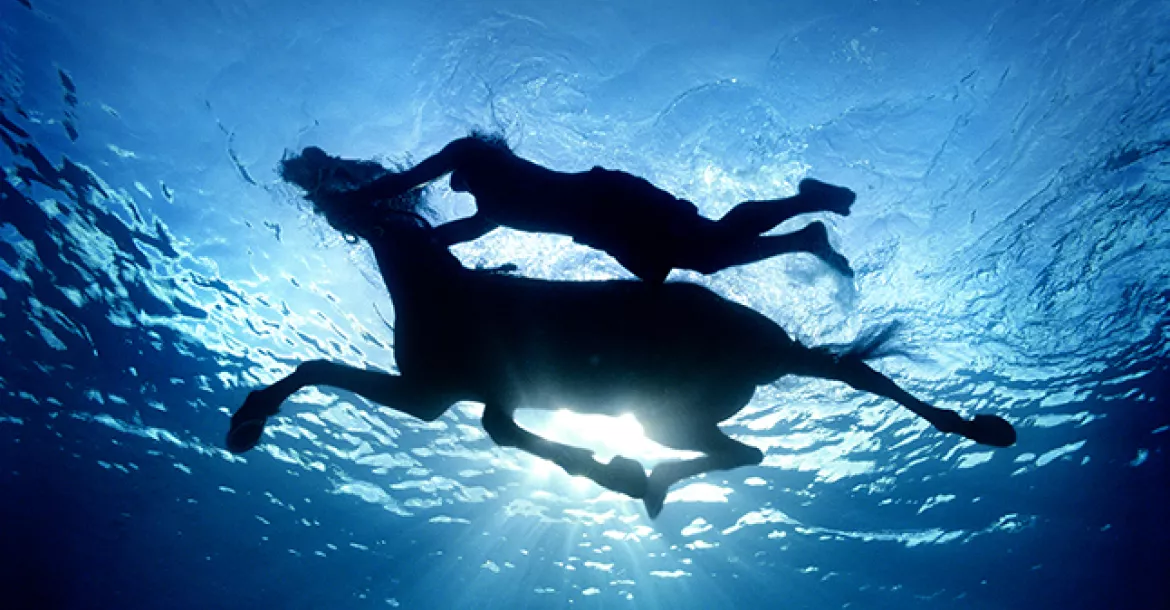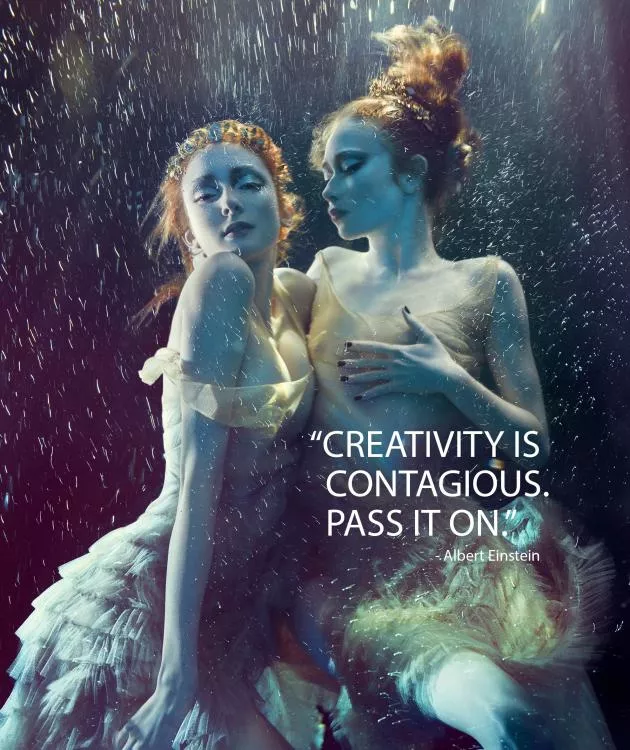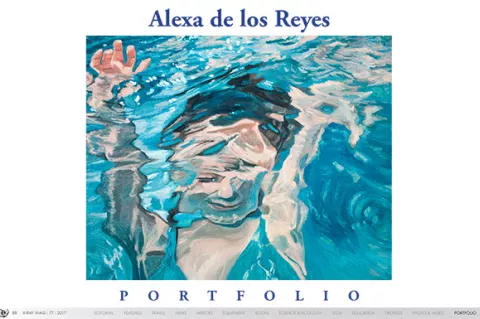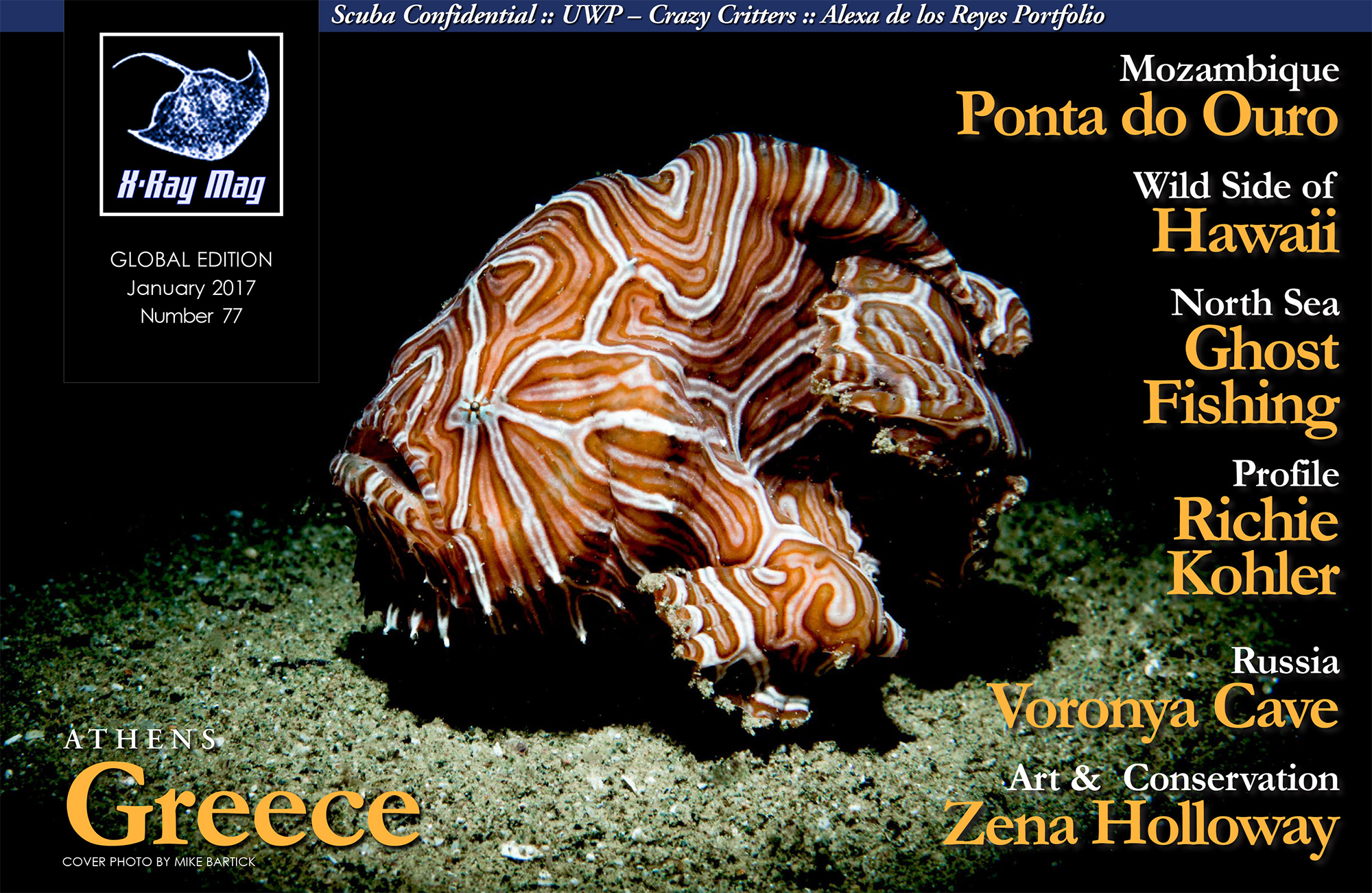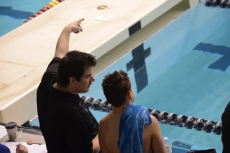Powerful images can help achieve a goal. Art can stir up emotions in people and emotions lead to action, leading to change. By conveying one strong message in a visually striking image, viewers may stop and think. They might decide to make real changes in their lives, affecting their friends and families—the message spreading outward, ultimately leading to a real and positive change all over the world. It all starts with a single image. To this end, British underwater photographer, Zena Holloway, uses her photographs to raise awareness of the fragile nature of our oceans and marine ecosystems. Ran and Danielle Mor interviewed the artist to find out more about her mission, passion and creative process.
Contributed by
Factfile
Ran and Danielle Mor have devoted their lives to scuba diving. Ran Mor is a divemaster and an underwater photography expert, and Danielle Mor is an experienced PADI and SSI instructor.
Together, they have founded Aqua Spirit Dive Expeditions, leading specialty dive trips around the world, oriented towards underwater photographers.
See: diveandmore.com.
REFERENCES:
¹ Sea Turtle Conservancy. “Information about sea turtles: Threats to sea turtles.” https://conserveturtles.org/information-sea-turtles-threats-marine-debris/
² Chin, C, (2016). "Enough with the plastic already: plastic bags." Center for Oceanic Awareness, Research and Education. http://www.coare.org/plasticbags.html
³ Quandt, K. (2014). “California just passed a plastic bag ban: Here's what you need to know.” Mother Jones. http://www.motherjones.com/environment/2014/09/california-bans-plastic-bags.
Ocean Conservancy, (2014). “Turning the tide of trash,” International Coastal Cleanup – 2014 report, 19. http://www.oceanconservancy.org/our-work/marine-debris/icc-data-2014.pdf
Underwater portrait and fashion photography is a unique form of art, allowing infinite creativity, pulling the viewer into the surreal, liquid world in which it was created. Holloway’s images convey this sense of surrealism. It is what makes her photos so powerful.
An underwater photographer based in London, Holloway discovered her passion for underwater photography in Egypt, when she was only 18. She fell in love with diving, and shortly after, began taking photos underwater as well.
Holloway decided to chart her own course in an ultra-niche profession. Nobody showed her the ropes. She taught herself. In 1997, she received her first commissioned work for a major brand, and since then, her work has been commissioned by many known brands, fashion designers, lifestyle magazines and celebrities. Among her clients, one can find Nike, Fabergé, Mastercard, Sony, Speedo, Elle Style, Herbal Essences and many more. Holloway is currently one of the top underwater portrait and fashion photographers in the world and very well known in the industry.
Thinking outside of the box
Photos capture a moment in time. Indeed, Holloway’s images seem to capture moments out of a dream. Refreshing and original, her work reaches beyond the conventional boundaries of underwater photography. Her photos lift one up and lead one to another world, a world where the impossible becomes possible and the confines of reality, as we know it, cease to exist.
Her motto is, “Think outside the box.” This is a necessary state of mind when working with the unpredictable, ever-flowing underwater world, she said. Creative thinking is the most prominent characteristic in her work, noticeable in both her commissioned and editorial images, as well as her fine art photography.
“My images illuminate the space between myth and reality,” said Holloway. “On the one side, our seas and oceans are powerful symbols from folklore and fairy tale, places of enchantment but also mystery and danger. On the other, water is an eternally present and powerful truth, nourishing, sustaining and commanding our respect. Somewhere in-between is a world of imagination that I am inspired to bring to life, in the process asking questions about ourselves, our relationship with water and our responsibilities to the natural environment.”
Holloway believes that every person should be passionate about one's own work, especially when creating art. One must work from the heart and without fear, she said. This is the only way to create something that is truly unique.
Technical and logistical skills
However, passion is not enough. According to Holloway, a photographer needs to master the technical and logistical skills of the art as well. She said one of her most challenging photo sessions, in which creative thinking outside of the box was a MUST, was her first photo shoot, which actually jump-started her career. Out of this session in 1998 in the Caribbean came her unique photo of horses swimming in the sea. It has won several awards since.
Horses in the sea. At the time, Holloway was intrigued by a popular television commercial featuring an elephant swimming in the ocean to grab a bottle of Diet Coke. She thought, if an elephant could make an interesting subject underwater, then why not try horses?
No doubt horses are not a common subject underwater, so snapping such a unique image was bound to create a visually striking photo. She jumped on a plane and flew over to a beach in the Caribbean where there was a local who was famous for his swimming horses.
During her two weeks there, Holloway spent plenty of time in the water with the horses. She was determined to capture the action from below, pulling the viewer deeper into the shot—a determination that almost cost Holloway her life! As it turned out, the horses moved rather quickly in the water, and she nearly got killed with a hoof in the head while positioning herself for this shot. Ultimately, the effort paid off.
Girl in a pool. Another interesting session was commissioned by Shangri-La Hotels in Taipei, Hong Kong. Holloway was asked to shoot a photo of a girl in a swimming pool, looking out onto Taipei at night. An odd request, but she happily accepted the challenge.
When planning the shoot, it was clear to her that the water would have to somehow combine with the skyline—which was not an easy task, she said, when shooting in the confined space of a swimming pool. Luckily, the pool location was quite deep, she said, reaching about 3m (10ft) in depth, sporting nice tiles with which to work in the image.
Holloway chose to use a 14mm ultra-wide angle lens, which is not her first choice when shooting underwater, she said. But in this case, the wide lens was crucial to create a sense of space that helped produce the original vision of the shoot. Holloway said, the lens was wide enough to allow the lighting to fall away at the edges of the image, which created the desired effect for the final image and helped create a smooth transition to a night sky.
Another important element in this shoot was the model’s pose, said Holloway. In order to create a powerful composition, Holloway asked the girl to lay back in a sleep-like state, a pose that does not come naturally for most people underwater. Holloway guided the model to the pose she had envisioned in her mind. After several attempts, with the model using a nose-clip, Holloway got the shot.
Global flood. Holloway said she is often presented with an idea, a concept related to water, which she is asked to bring to life. When GQ Russia was writing a piece about global warming and the rising water level, the magazine asked her to create a series of images, reflecting how various groups of people would react to a global flood: Unscrupulous people would take advantage of the opportunity to go to war and wreak havoc; businesspeople would cling onto their computers and technology; and people wanting to do good would venture out, seeking a solution and promoting peace.
Holloway came up with an idea for the “good people” shot. She envisioned them flying above the skyline, she said, searching vigorously for a solution to the world’s problems, lighting up the way with an underwater flashlight. But something was missing.
Prior to this commission, Holloway had been shooting a group of children for another commissioned work. She had fallen in love with the face of one of the girls in the group, who was “simply divine” underwater, she said, adding that the girl had the most perfect round little face and gentle features. Holloway called the girl’s parents and requested that the child join the current shoot. All the girl had to do, said Holloway, was cling onto one of the models while he was swimming.
The little girl was the final touch, said Holloway—“the cherry on top of the shoot,” she said, boosting the creative aspect of the photo and making the story a dozen times more interesting than imagined.
The final touch is a common element in Holloway’s work, she said, whether it is a little girl, winter vines from her garden as an accessory for an underwater ballet shoot, feathers placed in the right place on the image, or a printed poster of a stormy sea placed on the bottom of the pool as a background. Even when working with a large-scale production, said Holloway, it is often the little thing added in the last minute, which completes the tale and creates a truly unique image that really stands out and inspires.
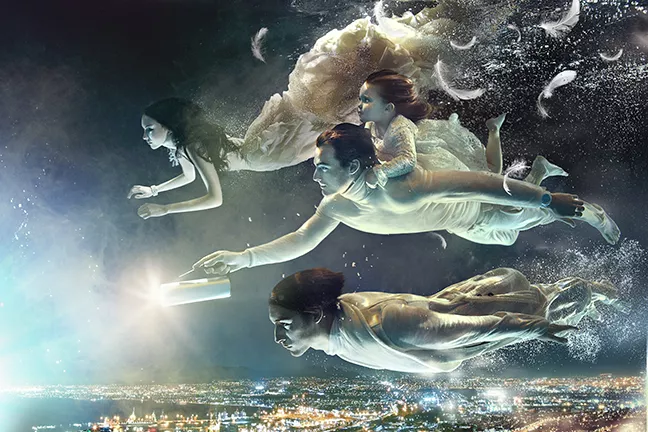
Creativity is contagious
For the first time in her career, Holloway has decided to share her vast experience with a lucky few, by conducting a unique underwater fashion masterclass in the clear waters of Bimini in the Bahamas. It will take place in April 2017, in collaboration with Aqua Spirit Dive Expeditions. “I hope to inspire people to think outside the box and bring something different to their pictures,” said Holloway.
The workshop will provide an interesting overview of the entire process of creating underwater fashion, said Holloway, including important technical skills, planning the shoot and logistics, post processing, as well as the business aspects of the industry. Apart for the technical and artistic aspects of underwater portrait photography, Holloway also plans to discuss how to use this medium to promote important agendas related to the ocean, the environment and marine life.
Using art for a greater cause
Ocean conservation is a subject dear to Holloway, as well as many divers and ocean lovers who simply want to protect that which is so close to their hearts. While a vast majority of underwater portraits are done in pools, said Holloway, her masterclass will take place mostly in the ocean. This decision was made, she said, in order to push the participants towards a higher level of creativity, but also to provide striking images which participants can then choose to contribute to a campaign promoting ocean conservation.
For the conservation campaign, Holloway and Aqua Spirit Dive Expeditions will be collaborating with Center for Oceanic Awareness, Research and Education (COARE), a non-profit organization that was created to raise awareness of the plight of the oceans. The organization strives to foster positive and lasting change in humankind’s attitude towards the oceans.
Conservation objectives
One of COARE's major fronts is the fight against unnecessary plastics. While plastic has made modern life better—with plenty of useful, cheap products embedded in every aspect of society—for the oceans, plastic is a ticking time bomb.
An example of the terrible effects plastic has on marine life is the thousands of sea turtles dying each year from feeding on plastic bags. They can easily mistake plastic bags for jellyfish, one of their natural food sources.¹
In the US state of California alone, a staggering 123,000 tons of plastic bags are thrown away every year. Recently, in a single worldwide beach clean-up day, 441,493 plastic bags were collected. Just think of how much plastic ends up in the oceans. It is a plague, in every sense of the word. Today’s plastic products are highly resilient, and unfortunately, built to last a lifetime, which is why they are so dangerous to the marine environment, taking ages to disintegrate, and even when they do, they remain a threat, releasing toxins and pollutants into the ocean ecosystems. ²
It is safe to say that divers and ocean lovers are very aware of the need to protect the ocean, and will rarely touch or harm anything underwater, let alone eat shark fin soup or other endangered marine life. However, how many are aware of the perils of taking coffee in a plastic to-go cup on their way to work, or using a straw when sipping a favorite soft drink? Are people aware of how much these habits put marine life at risk?
Only recently, after a long ongoing struggle led by COARE and other organizations, a legislative bill (SB270) was finally passed, effectively banning single-use plastic bags in the state of California. It is the first US state to pass such a law, and hopefully the rest of the United States will follow suit. ³
By raising awareness of the dangers of plastic and reaching the masses, we divers can make a real change, reduce plastic and save our beloved oceans, by simply changing our small daily habits, and those of everyone around us. It is what Holloway and Aqua Spirit hope to accomplish as one of the outcomes of the collaboration with COARE. ■

